Tomato Plant Problems & How to Solve Them
Home gardeners may experience disappointing results when growing tomatoes because the plants and fruit are susceptible to several common abiotic (nonliving) disorders, as well as attack by diseases and other pests. The nonliving causes are often attributable to environmental or cultural factors, or simply to the plant's genetic makeup. Here are common problems when growing tomatoes.
APHIDS
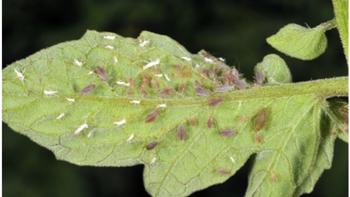
Curling, yellowing, and distortion of leaves and stunting of shoots; presence of a sticky exudate known as honeydew that often turns black with the growth of a sooty mold fungus
What’s the probable cause?
Living - Aphids (numerous species)
- Prune out infested leaves and stems.
- Knock off plants by shaking the plant or spraying it with a strong stream of water.
- Wait for hot weather; most aphids are heat-intolerant and will be gone by mid-June.
- Encourage beneficial insects such as lady beetles and lacewings and protect these good bugs by avoiding the use of insecticides that can be toxic to a broad variety of insects.
- Apply insecticidal soaps, soap-pyrethrum mixtures, or neem oils. Use soaps or oils when temperature is under 90°F to prevent possible “burn” damage to plants.
- Learn more.
BLOSSOM END ROT
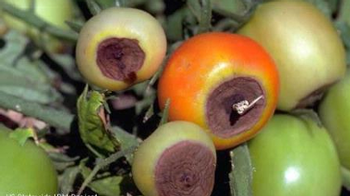
Water-soaked spot on blossom end of fruit enlarges and darkens, becomes sunken and leathery. Affects both green and ripe fruit, and is more common on sandier soils.
What’s the probable cause?
Nonliving - Calcium nutrition and water balance in the plant, aggravated by high soil salt content and fluctuating soil moisture.
Some solutions
- Maintain even soil moisture.
- Amend planting area with organic matter such as compost to improve water retention.
- Avoid heavy applications of high-nitrogen fertilizer.
- Soils that are deficient in calcium may be amended with gypsum.
EARLY BLIGHT
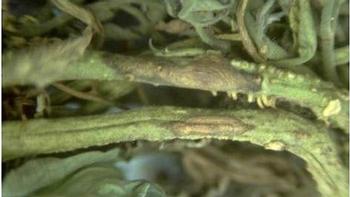
Black or brown spots, usually about 1 cm in diameter that appear on leaves, stems, and fruit. Leaf spots are leathery and often have a pattern of concentric rings; they usually appear on older leaves first. Fruit spots are sunken and dry and also have a concentric pattern.
What’s the probable cause?
Living - Fungus Alternaria solani
Some solutions:
- Avoid overhead irrigation.
- Crop rotation is useful in infested gardens.
- Copper fungicides applied at the first sign of infestation and repeated every 7 to 10 days may provide control.
FUSARIUM WILT
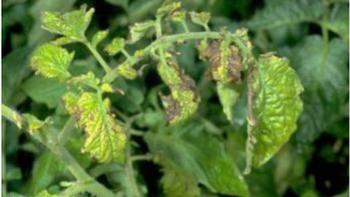
Infected plants turn yellow starting with one side or branch and gradually spreading through the plants, eventually killing them.
What’s the probable cause?
Living - Fungus Fusarium oxysporum, f. sp. lycopersici
Some solutions
- Plant resistant varieties which are indicated by the letters F or FF.
- Remove all residue, including roots, which may be susceptible to the disease from the soil that non- resistant varieties are to be planted in.
- Use soil solarization before you plant.
- Learn more.
LATE BLIGHT
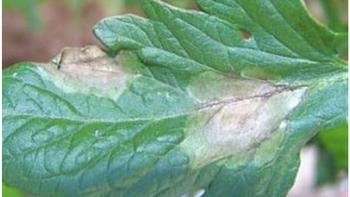
Lesions on leaves first appear as irregular, small pale to dark green water-soaked spots that are surrounded by a zone of yellowish tissue; they may expand rapidly and become brown to purplish black. Lesions on stems and petioles are brown to black. Fruit discoloration usually begins on the upper side of the fruit.
What’s the probable cause?
Living - Fungus Phytophthora infestans
Some solutions
- Avoid sprinkler irrigation.
- Destroy all tomato, potato, eggplant, and pepper debris after harvest.
- Learn more.
LEAF ROLL
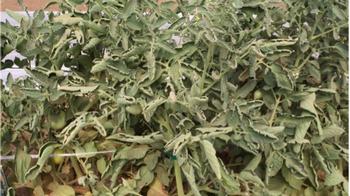
Firm and leathery leaves; the lowest leaves roll upward in wet spring conditions; the plant may appear wilted.
What’s the probable cause?
Nonliving – Cool air and soil temperatures
Some solutions
- Symptoms disappear when temperatures become warmer and soils dry out.
- Normal growth resumes and there is no damage to the fruit that develop later.
HORNWORMS
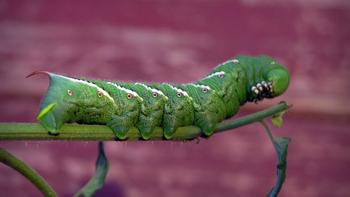
Entire leaves and small stems may be consumed; large pieces from green fruit mayalso be chewed.
What’s the probable cause?
Living - Hornworms (Manduca spp) of all sizes with a distinctive horn at the rear end; mature caterpillars are very large, up to 4 inches long.
Some solutions
- Handpick or snip hornworms with shears.
- Natural enemies normally keep populations under control.
- Hornworm eggs are attacked by Trichogramma parasites and the larvae by Hyposoter exigua.
- Bacillus thuringiensis or spinosad are effective against smaller larvae.
- Learn more.
NEMATODES
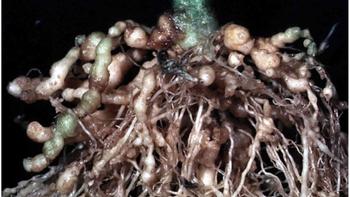
Distinctive swellings, called galls, on roots of affected plants; wilting during the hottest part of the day, even with adequate soil moisture, loss of vigor, yellowing leaves, and other symptoms similar to lack of water or nutrients; plants grow more slowly than neighboring healthy plants, beginning in early to mid-season; plants produce fewer and smaller leaves and fruits, those heavily infested early in the season can die
What’s the probable cause?
Living - Root knot nematodes; microscopic, eel-like roundworms (Meloidogyne spp).
Some solutions
- Management of nematodes is difficult.
- Purchase plants from reliable nurseries.
- Avoid moving plants and soil from infested parts of the garden.
- Plant resistant varieties.
- Learn more
SKIN SPLITTING OR CRACKING
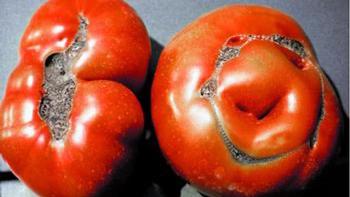
Circular concentric cracks around the stem end; cracks radiating outward from the stem; malformation and cracking at the blossom end (cat facing).
What’s the probable cause?
Nonliving - Periods of very fast growth with high temperatures and high soil moisture levels; wide fluctuations in soil moisture content or heavy rain following a dry period; wide differences in day and night temperatures; abnormally cool or hot conditions; any disturbance to the flower pans during blossoming.
Some solutions
- Choose varieties that are adapted to your climate zone and are less susceptible to cracking.
- Keep soil evenly moist.
- Maintain good leaf cover or provide partial shade in periods of high light intensit.
- Moderate soil temperatures and moisture with a layer of organic mulch 3 to 4 inches deep.
VERTICILLIUM WILT
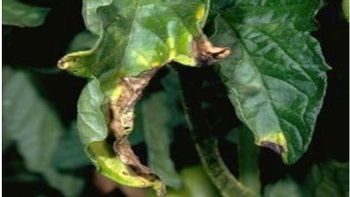
Starts as a yellowing between the major veins of the leaves; the fungus moves throughout the plant and eventually whole leaves and stems wither and die.
What’s the probable cause?
Living - Fungus Verticillium dahliae
Some solutions
- Plant resistant varieties which are labeled V.
- Remove all residue, including roots, which may be susceptible to the disease from soil non-resistant varieties are to be planted in.
- Use soil solarization before you plant.
- Learn more.
WHITEFLIES
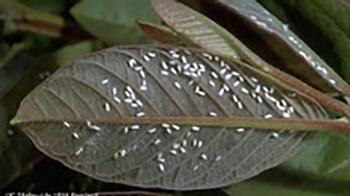
Yellowing, silvering, or drying leaves that have tiny nymphs on the undersides of leaves; sticky honeydew on leaves, fruit, or beneath plants or a covering of black, sooty mold
What’s the probable cause?
Living – Whiteflies (numerous species)
Some solutions
- Prune out infested leaves when you first detect them.
- Hose off adults or use a hand-held vacuum.
- Install ready-to-use, sticky-coated yellow traps, or make your own; use one trap for every medium-sized plant.
- Encourage beneficial insects such as lady beetles and lacewings and protect these good bugs by avoiding the use of insecticides that can be toxic to a broad variety of insects.
- Apply insecticidal soaps, soap-pyrethrum mixtures, or neem Use soaps or oils when temperature is under 90°F to prevent possible “burn” damage to plants.
- Remove infested plants.
- Learn more.
SUNSCALD
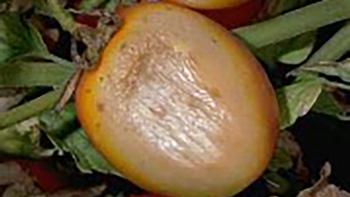
Fruit becomes brown and leathery on the side exposed to the sun.
What’s the probable cause?
Nonliving – Overexposure to sunlight
Some solutions
- Maintain plant vigor to produce adequate leaf cover.
- Avoid over-pruning.
- Provide partial shade during hours of most intense sunlight.
TOBACCO MOSAIC VIRUS
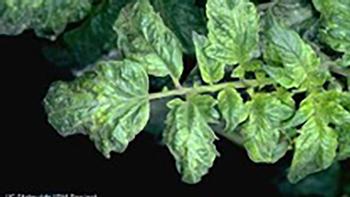
Mottled pattern of yellowing on tomato leaves. Leaves may also appear stringy or distorted. Symptoms can vary and be hard to distinguish from other common tomato viruses.
What’s the probable cause?
Living – Caused by virus strains that are easily transmitted. The most common sources of infection are the debris of infected plants that remains in the soil.
Some solutions
- Remove and destroy any symptomatic plants.
- Avoid use of tobacco around tomato plants.
- Use only certified virus-free seed.
- Sanitation is the single most recommended practice to control TMV, because transmission of the virus from plant to plant usually occurs from contaminated tools or hands.
- After removing diseased plants, wash your hands and decontaminate tools.
- Surface sterilize seeds with bleach before planting.
- There are no chemical sprays that will prevent, control, or eradicate viruses.
